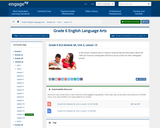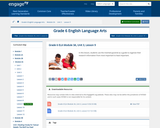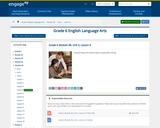
End of Unit Assessment: Final Essay
- Subject:
- English Language Arts
- Material Type:
- Lesson Plan
- Provider:
- EngageNY
- Author:
- Expeditionary Learning
- Date Added:
- 04/04/2014

End of Unit Assessment: Final Essay

In this lesson, students continue to draft their literary analysis essays. This lesson follows a similar structure as Lesson 9, direct instruction with the model literary analysis followed by students’ work on their own literary analysis essays.

In this lesson, students draft the introductory and concluding paragraphs of their End of Unit 2 Assessment literary analysis essay.

In this lesson, students read and analyze a model to determine the purpose of a newspaper article.

In this lesson, students work in triads to research factual information about the 1906 San Francisco earthquake and fire to use as a basis for their newspaper articles.

This lesson is an opportunity for students to review and revise their essays.

In this mid-unit assessment, students read a new excerpt from “Comprehending the Calamity” and analyze word/phrase meaning; the ways the author has conveyed her point of view of the relief camps; and how the author has introduced, illustrated, and elaborated on relief camps.

In Lessons 9–11, students draft their literary analysis essays. Each lesson has a similar structure of direct instruction with the model literary analysis followed by students’ work on their own literary analysis essays.

In this lesson, students use their research to determine the who, what, where, when, and why of their newspaper article.

In this lesson, students evaluate the information they collected through research in the first half of the unit in order to identify the information that is most relevant to the angle they are taking in their newspaper article.

In this lesson, students evaluate the eyewitness quotes they have collected in order to choose those most relevant to the factual information while also being compelling.

In this lesson, students use the inverted pyramid as a guide to organize their research information from most important to least important.

In this lesson, students begin the End of Unit 3 Assessment. To do so, they draft the written content of their informative consumer guide using their Quote Sandwich graphic organizers.

In this lesson, students analyze authentic informative consumer guides to determine the features they need to include on their own guides. Students also select images they would like to use in their guides in this lesson.

This lesson launches the performance task in which students will create an informative consumer guide to answer the question: What do consumers need to know about overfishing and fish depletion when buying fish?

In this lesson, students work in triads to research information about overfishing.

In this lesson, students work in triads to research a case study of a depleted fish species.

In this lesson, students work in triads to research information about sustainable fishing methods.

In this lesson, students evaluate the information and quotes, recorded on their Researching graphic organizers in Lesson 2, about the issue of overfishing and fish depletion to identify relevant and compelling information to use in their informative consumer guides.

In this lesson, students continue working on their Informative Consumer Guide: The Issue of Overfishing and Fish Depletion.